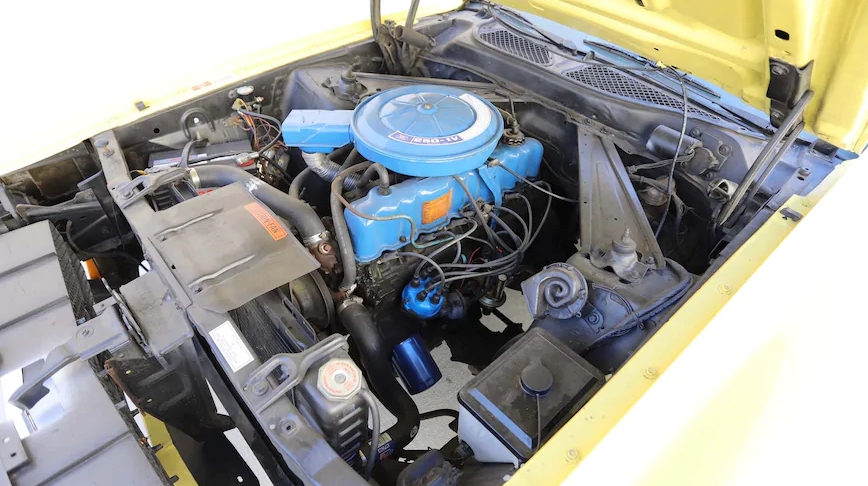200-I6
The 200 cu in I-6 engine model was introduced in the middle of 1963 with 3.685 by 3.126 in (93.6 by 79.4 mm) bore and stroke, and shared the four main bearing design of the 170. Early 200s can be identified by three freeze plugs. Beginning in 1965, the 200s were upgraded to seven main bearings to reduce harmonic vibrations and increase durability. 1965 and later engines can be identified by five freeze plugs and the casting code C5DE-H. The 1965 Mustang (August 1964 onward) used this engine as standard, rated at 120 hp (89 kW). The Mustang continued to use the 200 as its base engine until it was dropped in 1971. Starting in 1966, a six-bolt bellhousing flange block was introduced. Beginning in 1980, the block was redesigned with a bell housing flange and a low-mount starter very similar to the small-block Ford V8. This version is easily identified by starter location down by the oil pan rail and is referred to as the Big Bell 200. The big bell design is uncommon but sought after by I-6 performance enthusiasts because it can be modified to accept a Ford small block V8 six bolt bell housing.
When Ford launched the third-generation Fox body Mustang in 1979, the original engine lineup included the Cologne V6. The same engine was also offered in the hugely successful Ford of Europe Capri Mk II. The 2.8 L V6 engine was a popular option for the US Mustang and the European Capri MkII and as a result the Cologne engine plant could not meet the demand for engines for both continents. So, the Cologne 2.8 L V6 was dropped from the Mustang’s engine lineup in the middle of the 1979 production year and replaced with the 200cid Falcon inline six, which was now referred to as the 3.3L engine. The engine and front suspension K-member was transferred from the Fairmont, which helped reduce costs instead of having to redesign the Mustang for a different engine.
The 200 was used in the Ford Maverick and Mercury Comet and continued in the Fairmont (and essentially identical Mercury Zephyr) until these were replaced at the end of the 1983 model year. The Ford Granada and Mercury Monarch offered the 250ci L6 (’75-’80) and then the 200ci L6 (’81-’82) as part of their engine lineup, when they were replaced in 1983 by the Ford LTD and the Mercury Marquis. These two models used the engine from 1983 to 1984 when it was replaced by the 3.8 L Essex V6.
Ford was also having problems meeting demand for its 2.3 L OHC engine which was used in a multitude of models worldwide. In anticipation of another engine shortage, Ford’s Lima, Ohio, engine plant, which was already producing the 2.3 L OHC engine, decided they could modify the Falcon inline six block casting molds to remove cylinders 4 and 5 to create a four-cylinder engine. A cast iron high-swirl cylinder head was developed, and the motor was designated the 2.3 L HSC to help differentiate it from the same displacement 2.3 L OHC design. This motor shared many common parts with the 200, and it is common for persons rebuilding their 200 engines to use the 2.3 L HSC pistons as a cheap replacement.
Applications:
- 1963-1967 Ford Ranchero
- 1963-1969 Ford Fairlane (Americas)
- 1964-1970 Ford Falcon (North America)
- 1965-1971;1979-1982 Ford Mustang
- 1968-1969 Ford Torino
- 1970-1977 Ford Maverick (Americas)
- 1975-1980 Ford Granada (North America)
- 1978-1980 Ford Fairmont
- 1973-1977 Ford Bronco
- 1980-1982 Ford Thunderbird (eighth generation)
- 1983-1984 Ford LTD (Americas)
- 1964-1967;1971-1977 Mercury Comet
- 1975-1980 Mercury Monarch
- 1978-1983 Mercury Zephyr
- 1979-1982 Mercury Capri
- 1983-1984 Mercury Marquis
250-I6
The 250 cu. in. I-6 engine option was offered in 1969 in the Mustang, and 1970 in compact Ford cars (Maverick). The 250 was a stroked 200, made by changing the stroke from 3.126″ to 3.91″ (99,314 mm). Output was 155 hp (115 kW) in the Mustang, and became the base engine in 1971. The Ford Granada and Mercury Monarch offered the 250ci L6 (’75-’80) and then the 200ci L6 (’81-’82) as part of their engine lineup, when they were replaced in 1983 by the Ford LTD and the Mercury Marquis.
Power was re-evaluated at 98 hp (73 kW) for 1972 (due to power rating changes) and 88 hp (66 kW) the next year. This engine had seven main bearings, and can be identified by the five freeze (core) plugs on the side of the block. The block uses a low-mount starter and six bell housing bolts, sharing its bell housing with the Windsor V-8s 302-351W, late (1965–68) 289,early 4.6, and the 240-300 CID Ford Six. The last year of production for the 250 was 1980.
Applications:
- 1968-1976 Ford Ranchero
- 1968-1973 Ford Torino
- 1969-1973 Ford Mustang
- 1970-1977 Ford Maverick (Americas)
- 1975-1980 Ford Granada (North America)
- 1968-1969 Mercury Comet
- 1972-1976 Mercury Montego
- 1975-1980 Mercury Monarch
